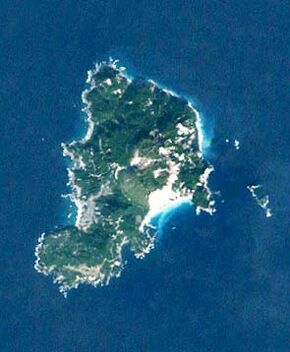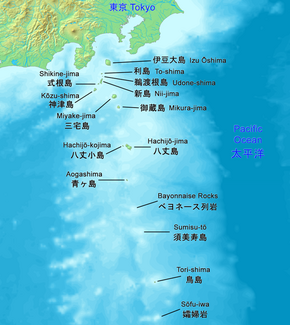Earth:Kōzu-shima
| Native name: 神津島 | |
|---|---|
 Landsat image of Kōzu-shima | |
 | |
| Geography | |
| Location | Izu Islands |
| Coordinates | [ ⚑ ] 34°12′58″N 139°09′23″E / 34.21611°N 139.15639°E |
| Archipelago | Izu Islands |
| Area | 18.48 km2 (7.14 sq mi) |
| Length | 6 km (3.7 mi) |
| Width | 4 km (2.5 mi) |
| Coastline | 22,000 m (72000 ft) |
| Highest elevation | 571 m (1873 ft) |
| Administration | |
Japan | |
| Prefecture | Tokyo |
| Subprefecture | Ōshima Subprefecture |
| Village | Kozushima |
| Demographics | |
| Population | 1952 (June 2017) |
| Additional information | |
| <mapframe height="200" zoom="10" frameless="1" width="300">{"properties":{"stroke-width":1,"stroke":"#000000","title":"Kōzu-shima"},"type":"ExternalData","service":"geoshape"}</mapframe> | |
Kōzu-shima (神津島) is a volcanic Japanese island in the Philippine Sea.[1] The island is administered by Tōkyō and is located approximately 30 kilometres (19 mi) northwest of the Miyake-jima and 14 kilometres (8.7 mi) southwest of the Nii-jima. It is one of the Izu Seven Islands group of the seven northern islands of the Izu archipelago. Kōzushima is administratively part of Kōzushima Village under Ōshima Subprefecture of Tokyo Metropolis. (As of 2017), the island's population was 1,952. Kōzushima is also within the boundaries of the Fuji-Hakone-Izu National Park.
Geology
Kōzu-shima is a compound volcanic island 6 km in length with a maximum width of 4 km. The island is formed from a cluster of eighteen lava domes, with rhyolite and pyroclastic ash deposits. The highest of these lava domes, Tenjō-san (天上山), has a height of 571 metres (1,873 ft), and was last active in 838 AD per the ancient Japanese history Shoku Nihon Kōki. Compared with most of the other islands in the Izu archipelago, Kōzu-shima is relatively flat, with small eroded hills, and lacks the high coastal cliffs found on the other islands. Earthquake swarms have occurred at Kōzu-shima during the 20th century.
Climate
Important Bird Area
The island has been recognised as an Important Bird Area (IBA) by BirdLife International because it supports populations of Japanese wood pigeons, Tristram's storm petrels, Japanese murrelets, Ijima's leaf-warblers, Pleske's grasshopper warblers and Izu thrushes.[2]
History
Kōzu-shima has been inhabited since at least the Japanese Paleolithic era, and archaeologists have found Jōmon period stone tools made from obsidian in Shizuoka and Yamanashi Prefectures. Under the Ritsuryō system of the early Nara period, the island was part of Suruga Province. It was transferred to Izu Province when Izu separated from Suruga in 680 AD. During the Heian period, obsidian was the primary export from the island.
See also
- List of islands of Japan
- List of volcanoes in Japan
Notes
- ↑ Nussbaum, Louis-Frédéric. (2005). "Izu Shotō," Japan Encyclopedia, p. 412.
- ↑ "Kozushima island". BirdLife International. 2021. http://datazone.birdlife.org/site/factsheet/kozushima-island-iba-japan.
References
- Teikoku's Complete Atlas of Japan, Teikoku-Shoin., Ltd. Tokyo 1990, ISBN:4-8071-0004-1
External links
- Kozushima Village Official Website
- Kozushima - Japan Meteorological Agency (in Japanese)
- "Kozushima: National catalogue of the active volcanoes in Japan". http://www.data.jma.go.jp/svd/vois/data/tokyo/STOCK/souran_eng/volcanoes/061_kozushima.pdf. - Japan Meteorological Agency
- Kozu Shima Volcano Group - Geological Survey of Japan
- "Kozushima". Smithsonian Institution. https://volcano.si.edu/volcano.cfm?vn=284030.
 |

